Witold Pedrycz
HyColor: An Efficient Heuristic Algorithm for Graph Coloring
Jun 09, 2025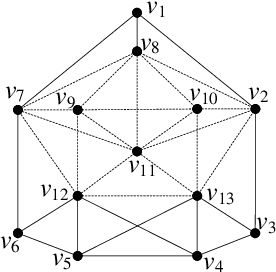
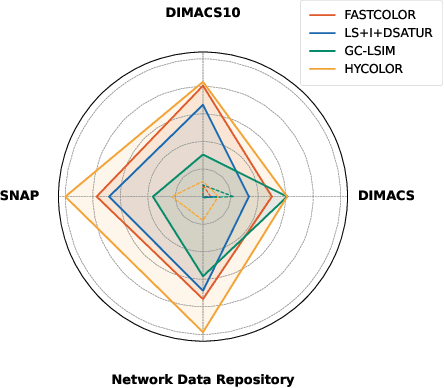

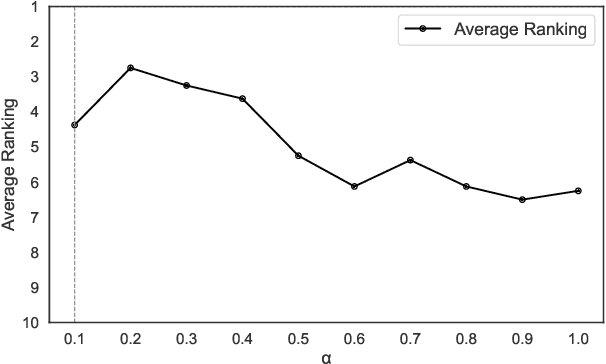
Abstract:The graph coloring problem (GCP) is a classic combinatorial optimization problem that aims to find the minimum number of colors assigned to vertices of a graph such that no two adjacent vertices receive the same color. GCP has been extensively studied by researchers from various fields, including mathematics, computer science, and biological science. Due to the NP-hard nature, many heuristic algorithms have been proposed to solve GCP. However, existing GCP algorithms focus on either small hard graphs or large-scale sparse graphs (with up to 10^7 vertices). This paper presents an efficient hybrid heuristic algorithm for GCP, named HyColor, which excels in handling large-scale sparse graphs while achieving impressive results on small dense graphs. The efficiency of HyColor comes from the following three aspects: a local decision strategy to improve the lower bound on the chromatic number; a graph-reduction strategy to reduce the working graph; and a k-core and mixed degree-based greedy heuristic for efficiently coloring graphs. HyColor is evaluated against three state-of-the-art GCP algorithms across four benchmarks, comprising three large-scale sparse graph benchmarks and one small dense graph benchmark, totaling 209 instances. The results demonstrate that HyColor consistently outperforms existing heuristic algorithms in both solution accuracy and computational efficiency for the majority of instances. Notably, HyColor achieved the best solutions in 194 instances (over 93%), with 34 of these solutions significantly surpassing those of other algorithms. Furthermore, HyColor successfully determined the chromatic number and achieved optimal coloring in 128 instances.
MAMBO-NET: Multi-Causal Aware Modeling Backdoor-Intervention Optimization for Medical Image Segmentation Network
May 28, 2025Abstract:Medical image segmentation methods generally assume that the process from medical image to segmentation is unbiased, and use neural networks to establish conditional probability models to complete the segmentation task. This assumption does not consider confusion factors, which can affect medical images, such as complex anatomical variations and imaging modality limitations. Confusion factors obfuscate the relevance and causality of medical image segmentation, leading to unsatisfactory segmentation results. To address this issue, we propose a multi-causal aware modeling backdoor-intervention optimization (MAMBO-NET) network for medical image segmentation. Drawing insights from causal inference, MAMBO-NET utilizes self-modeling with multi-Gaussian distributions to fit the confusion factors and introduce causal intervention into the segmentation process. Moreover, we design appropriate posterior probability constraints to effectively train the distributions of confusion factors. For the distributions to effectively guide the segmentation and mitigate and eliminate the Impact of confusion factors on the segmentation, we introduce classical backdoor intervention techniques and analyze their feasibility in the segmentation task. To evaluate the effectiveness of our approach, we conducted extensive experiments on five medical image datasets. The results demonstrate that our method significantly reduces the influence of confusion factors, leading to enhanced segmentation accuracy.
Margin-aware Fuzzy Rough Feature Selection: Bridging Uncertainty Characterization and Pattern Classification
May 21, 2025Abstract:Fuzzy rough feature selection (FRFS) is an effective means of addressing the curse of dimensionality in high-dimensional data. By removing redundant and irrelevant features, FRFS helps mitigate classifier overfitting, enhance generalization performance, and lessen computational overhead. However, most existing FRFS algorithms primarily focus on reducing uncertainty in pattern classification, neglecting that lower uncertainty does not necessarily result in improved classification performance, despite it commonly being regarded as a key indicator of feature selection effectiveness in the FRFS literature. To bridge uncertainty characterization and pattern classification, we propose a Margin-aware Fuzzy Rough Feature Selection (MAFRFS) framework that considers both the compactness and separation of label classes. MAFRFS effectively reduces uncertainty in pattern classification tasks, while guiding the feature selection towards more separable and discriminative label class structures. Extensive experiments on 15 public datasets demonstrate that MAFRFS is highly scalable and more effective than FRFS. The algorithms developed using MAFRFS outperform six state-of-the-art feature selection algorithms.
LGBQPC: Local Granular-Ball Quality Peaks Clustering
May 16, 2025Abstract:The density peaks clustering (DPC) algorithm has attracted considerable attention for its ability to detect arbitrarily shaped clusters based on a simple yet effective assumption. Recent advancements integrating granular-ball (GB) computing with DPC have led to the GB-based DPC (GBDPC) algorithm, which improves computational efficiency. However, GBDPC demonstrates limitations when handling complex clustering tasks, particularly those involving data with complex manifold structures or non-uniform density distributions. To overcome these challenges, this paper proposes the local GB quality peaks clustering (LGBQPC) algorithm, which offers comprehensive improvements to GBDPC in both GB generation and clustering processes based on the principle of justifiable granularity (POJG). Firstly, an improved GB generation method, termed GB-POJG+, is developed, which systematically refines the original GB-POJG in four key aspects: the objective function, termination criterion for GB division, definition of abnormal GB, and granularity level adaptation strategy. GB-POJG+ simplifies parameter configuration by requiring only a single penalty coefficient and ensures high-quality GB generation while maintaining the number of generated GBs within an acceptable range. In the clustering phase, two key innovations are introduced based on the GB k-nearest neighbor graph: relative GB quality for density estimation and geodesic distance for GB distance metric. These modifications substantially improve the performance of GBDPC on datasets with complex manifold structures or non-uniform density distributions. Extensive numerical experiments on 40 benchmark datasets, including both synthetic and publicly available datasets, validate the superior performance of the proposed LGBQPC algorithm.
Rethinking Label-specific Features for Label Distribution Learning
Apr 27, 2025Abstract:Label distribution learning (LDL) is an emerging learning paradigm designed to capture the relative importance of labels for each instance. Label-specific features (LSFs), constructed by LIFT, have proven effective for learning tasks with label ambiguity by leveraging clustering-based prototypes for each label to re-characterize instances. However, directly introducing LIFT into LDL tasks can be suboptimal, as the prototypes it collects primarily reflect intra-cluster relationships while neglecting interactions among distinct clusters. Additionally, constructing LSFs using multi-perspective information, rather than relying solely on Euclidean distance, provides a more robust and comprehensive representation of instances, mitigating noise and bias that may arise from a single distance perspective. To address these limitations, we introduce Structural Anchor Points (SAPs) to capture inter-cluster interactions. This leads to a novel LSFs construction strategy, LIFT-SAP, which enhances LIFT by integrating both distance and direction information of each instance relative to SAPs. Furthermore, we propose a novel LDL algorithm, Label Distribution Learning via Label-specifIc FeaTure with SAPs (LDL-LIFT-SAP), which unifies multiple label description degrees predicted from different LSF spaces into a cohesive label distribution. Extensive experiments on 15 real-world datasets demonstrate the effectiveness of LIFT-SAP over LIFT, as well as the superiority of LDL-LIFT-SAP compared to seven other well-established algorithms.
ZeroLM: Data-Free Transformer Architecture Search for Language Models
Mar 24, 2025Abstract:Neural architecture search (NAS) provides a systematic framework for automating the design of neural network architectures, yet its widespread adoption is hindered by prohibitive computational requirements. Existing zero-cost proxy methods, while reducing search overhead, demonstrate inadequate performance in architecture ranking tasks, particularly for Transformer-based models where they often underperform simple parameter counting metrics. Current automated proxy discovery approaches suffer from extended search times, susceptibility to data overfitting, and structural complexity. This paper introduces a novel zero-cost proxy methodology that quantifies model capacity through efficient weight statistics computation while decomposing Transformer architectures into functionally distinct sub-modules, thereby optimizing the balance of their contributions to overall performance. Our comprehensive evaluation demonstrates the superiority of this approach, achieving a Spearman's rho of 0.76 and Kendall's tau of 0.53 on the FlexiBERT benchmark. The proposed method exhibits exceptional computational efficiency while maintaining robust performance across diverse NAS benchmark tasks, offering a practical solution for large-scale architecture search.
Bridging Visualization and Optimization: Multimodal Large Language Models on Graph-Structured Combinatorial Optimization
Jan 21, 2025

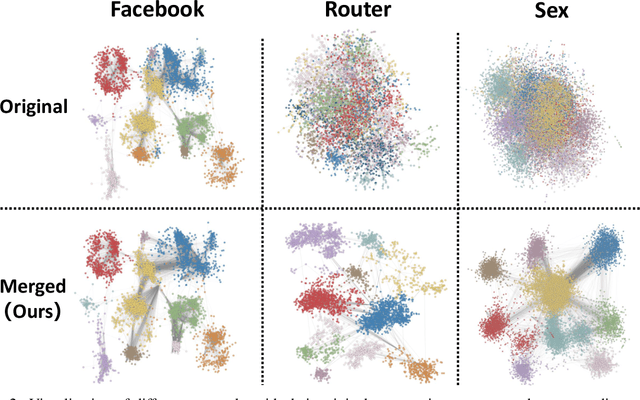

Abstract:Graph-structured combinatorial challenges are inherently difficult due to their nonlinear and intricate nature, often rendering traditional computational methods ineffective or expensive. However, these challenges can be more naturally tackled by humans through visual representations that harness our innate ability for spatial reasoning. In this study, we propose transforming graphs into images to preserve their higher-order structural features accurately, revolutionizing the representation used in solving graph-structured combinatorial tasks. This approach allows machines to emulate human-like processing in addressing complex combinatorial challenges. By combining the innovative paradigm powered by multimodal large language models (MLLMs) with simple search techniques, we aim to develop a novel and effective framework for tackling such problems. Our investigation into MLLMs spanned a variety of graph-based tasks, from combinatorial problems like influence maximization to sequential decision-making in network dismantling, as well as addressing six fundamental graph-related issues. Our findings demonstrate that MLLMs exhibit exceptional spatial intelligence and a distinctive capability for handling these problems, significantly advancing the potential for machines to comprehend and analyze graph-structured data with a depth and intuition akin to human cognition. These results also imply that integrating MLLMs with simple optimization strategies could form a novel and efficient approach for navigating graph-structured combinatorial challenges without complex derivations, computationally demanding training and fine-tuning.
Fuzzy Granule Density-Based Outlier Detection with Multi-Scale Granular Balls
Jan 06, 2025



Abstract:Outlier detection refers to the identification of anomalous samples that deviate significantly from the distribution of normal data and has been extensively studied and used in a variety of practical tasks. However, most unsupervised outlier detection methods are carefully designed to detect specified outliers, while real-world data may be entangled with different types of outliers. In this study, we propose a fuzzy rough sets-based multi-scale outlier detection method to identify various types of outliers. Specifically, a novel fuzzy rough sets-based method that integrates relative fuzzy granule density is first introduced to improve the capability of detecting local outliers. Then, a multi-scale view generation method based on granular-ball computing is proposed to collaboratively identify group outliers at different levels of granularity. Moreover, reliable outliers and inliers determined by the three-way decision are used to train a weighted support vector machine to further improve the performance of outlier detection. The proposed method innovatively transforms unsupervised outlier detection into a semi-supervised classification problem and for the first time explores the fuzzy rough sets-based outlier detection from the perspective of multi-scale granular balls, allowing for high adaptability to different types of outliers. Extensive experiments carried out on both artificial and UCI datasets demonstrate that the proposed outlier detection method significantly outperforms the state-of-the-art methods, improving the results by at least 8.48% in terms of the Area Under the ROC Curve (AUROC) index. { The source codes are released at \url{https://github.com/Xiaofeng-Tan/MGBOD}. }
Machine Learning Innovations in CPR: A Comprehensive Survey on Enhanced Resuscitation Techniques
Nov 03, 2024Abstract:This survey paper explores the transformative role of Machine Learning (ML) and Artificial Intelligence (AI) in Cardiopulmonary Resuscitation (CPR). It examines the evolution from traditional CPR methods to innovative ML-driven approaches, highlighting the impact of predictive modeling, AI-enhanced devices, and real-time data analysis in improving resuscitation outcomes. The paper provides a comprehensive overview, classification, and critical analysis of current applications, challenges, and future directions in this emerging field.
Linguistic Fuzzy Information Evolution with Random Leader Election Mechanism for Decision-Making Systems
Oct 19, 2024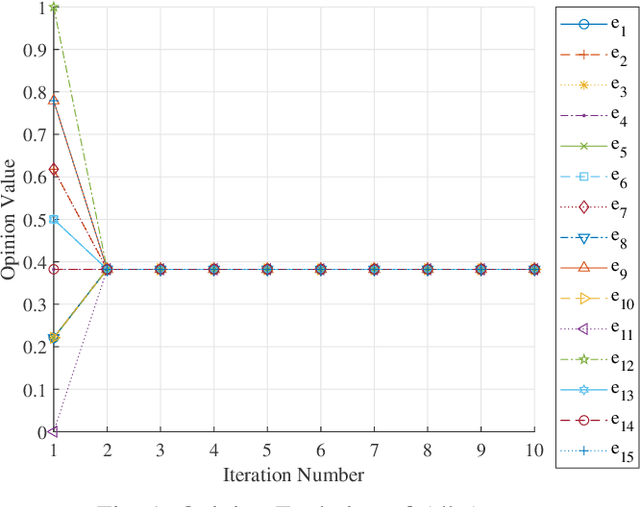
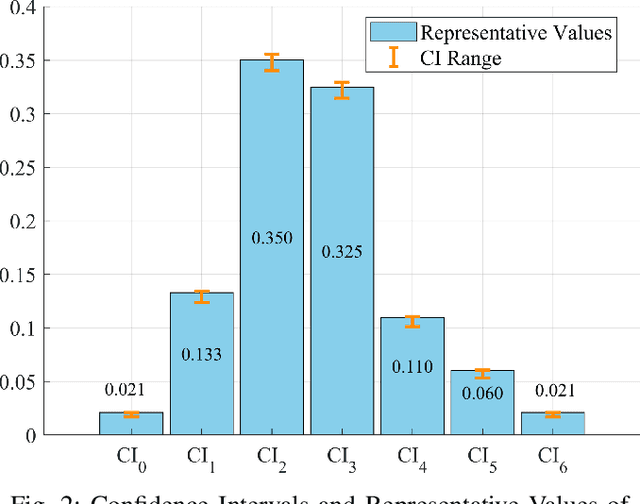
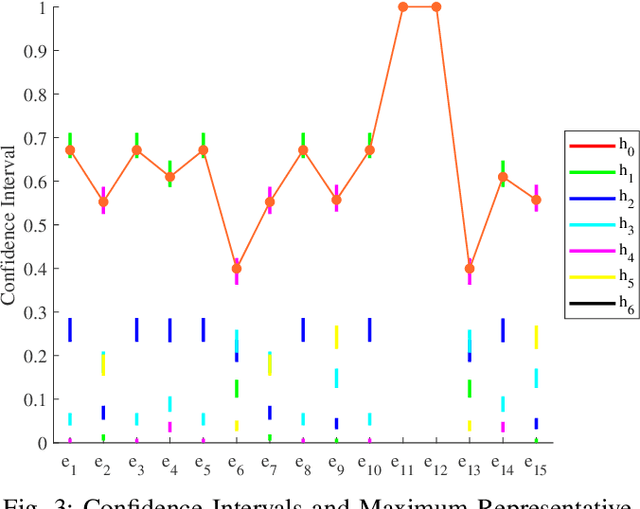

Abstract:Linguistic fuzzy information evolution is crucial in understanding information exchange among agents. However, different agent weights may lead to different convergence results in the classic DeGroot model. Similarly, in the Hegselmann-Krause bounded confidence model (HK model), changing the confidence threshold values of agents can lead to differences in the final results. To address these limitations, this paper proposes three new models of linguistic fuzzy information dynamics: the per-round random leader election mechanism-based DeGroot model (PRRLEM-DeGroot), the PRRLEM-based homogeneous HK model (PRRLEM-HOHK), and the PRRLEM-based heterogeneous HK model (PRRLEM-HEHK). In these models, after each round of fuzzy information updates, an agent is randomly selected to act as a temporary leader with more significant influence, with the leadership structure being reset after each update. This strategy increases the information sharing and enhances decision-making by integrating multiple agents' evaluation information, which is also in line with real life (\emph{Leader is not unchanged}). The Monte Carlo method is then employed to simulate the behavior of complex systems through repeated random tests, obtaining confidence intervals for different fuzzy information. Subsequently, an improved golden rule representative value (GRRV) in fuzzy theory is proposed to rank these confidence intervals. Simulation examples and a real-world scenario about space situational awareness validate the effectiveness of the proposed models. Comparative analysis with the other models demonstrate our ability to address the echo chamber and improve the robustness.
 Add to Chrome
Add to Chrome Add to Firefox
Add to Firefox Add to Edge
Add to Edge